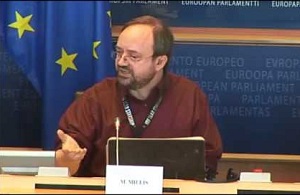Although I’m taking a break from posting, a recent note from Marc Millis suggests something productive that can happen while I’m gone. The founding architect of the Tau Zero Foundation and former head of NASA’s Breakthrough Propulsion Physics project, Marc deals with the issues he asks about below on a daily basis, and so do I. But compiling accurate, non-conflicting information about them can be tricky, which is why we could use your help. Read on.
by Marc Millis

While Paul is away, I have a request for you. We have a number of questions for which we need some help to find reliable answers. For all of you who have been wanting to help, here now is a chance.
When answering these questions, we need to know where you got the information. Please cite the document where you found the information. We are looking for reliable information, so avoid articles that cite values to advocate a particular solution. We have found that some papers skew estimates for such things so that it will support their other assertions (yes, it does happen). Instead, we want information that is without bias. It is even better if that information includes uncertainty ranges to help convey how much the values might vary, and why.
1) What is the minimal sustainable population size for planning world ships?
2) What are the minimum requirements to keep each person alive (volume, biological throughputs [water, food/waste, air], energy)?
3) What is the maximum demonstrated rocket specific impulse (empirical, not theoretical)?
4) What is the minimum energy required to send a detectable signal back to Earth from 4.5 light-years distance?
5) What is the maximum demonstrated duration for reliable operation of contemporary spacecraft hardware?
6) What are the estimates for the maximum duration for reliable operation of space hardware? In other words, what is best warranty period we can anticipate for a deep space probe?
7) What is the best demonstrated pointing accuracy for beamed energy (lasers, microwaves)?
8) Using our own Earth as an example of an extraterrestrial world, how close would our SETI – type detectors need to be in order to detect signals coming from our current emission levels from Earth?
We are looking for the information in this format:
• Value, +/- uncertainty.
• Academic style citation for the document where you got that value (No URLs!).
Example:
• Experimentally measured specific impulse: 17,200 +/- 10% sec
• Byers, D. C. (1969) An Experimental Investigation of a High Voltage Electron Bombardment Ion Thruster, Journal of the Electrochemical Society, Vol. 116, No.1, pp. 9-17.
Post your answers in the comments. Paul tells me he is moderating these daily.



hmm… also the propulsion beam can be redirected by the ship by employing a released deflector device
i really think targeting is not so much the way for beamed propulsion compared to “riding”
there are numerous options for redirecting and bundling the beam for enhanced coherence “in situ”
minimum viable population……………………………..
Moore John, H. ”Kin-Based Crews for Interstellar Multi-Generational Space Travel.” Kondo Yoji, Frederick Bruhweiler, John Moore, Charles Sheffield (a cura di), Interstellar Travel and Multi-Generation Space Ships, Collectors Guide Publishing, Burlington, Ontario, Canada (2003).
Newscientist.com. ””Magic number” for space pioneers calculated – 15 February 2002 – New Scientist.” 2002. Web. 27 Jul 2013. .
Smith, Cameron McPherson, and Evan Tyler Suliëman Davies. Emigrating Beyond Earth: Human Adaptation and Space Colonization. Springer, 2012.